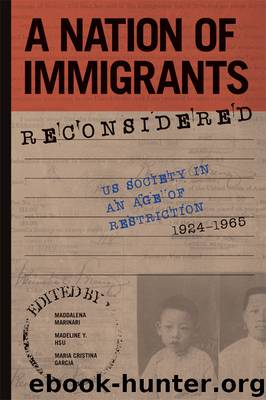A Nation of Immigrants Reconsidered by unknow

Author:unknow
Language: eng
Format: epub
ISBN: 9780252042218
Publisher: University of Illinois Press
Published: 2018-01-15T07:00:00+00:00
CHAPTER 8
Japanese Agricultural Labor Program
Temporary Worker Immigration, US-Japan Cultural Diplomacy, and Ethnic Community Making among Japanese Americans
EIICHIRO AZUMA
In September 1956 the “Japanese agricultural worker program” (Nōgyō rōmusha habei jigyō) was launched with the arrival of nearly four hundred temporary workers (known as tannō) from Japan who were sent to rural farm districts in California. Operating across several phases, this scheme brought a total of forty-one hundred Japanese to the Golden State before the program came to an end in October 1966. Unlike other guest farmworker programs, the Japanese labor importation scheme has largely escaped scholarly attention.1 Nonetheless, the Japanese agricultural worker program is highly noteworthy in its implications for three interrelated themes: ethnic and class politics of second-generation Japanese Americans (Nisei), Cold War US diplomacy and Japanese/Japanese American collaborations, and postwar manifestations of Japan’s colonial expansionism. The intersections between immigration and labor fostered these developments while advancing the varied interests of diverse historical agents, including Japanese American farmers and community leaders, California’s agribusiness elite, government officials, and social elites of the United States and Japan, alongside the young men who came to California as guest workers.
This chapter explains the diverse origins of and varied meanings attached to the immigration of temporary farmworkers from Japan, and particularly middle-class Nisei’s attempts to present themselves as assimilated Americans vis-à-vis alien Japanese laborers. To reveal these developments, I employ two interpretive frameworks. First, an inter-imperial framework illuminates colonial collusions between the United States and Japan, albeit under the former’s definitive dominance, in the Cold War context. Instead of a familiar narrative of US global hegemony and economic imperialism through guest worker importation, this chapter considers how the remnants of Japanese expansionism dovetailed with American Cold War diplomacy by implementing a scheme of supplementary-farm-labor immigration disguised first as “refugee” migration and then as an educational/training program. The second frame of analysis presents an intraracial perspective that elucidates how Japanese Americans deployed the Japanese agricultural worker program to serve the interests of Nisei farmers and community leaders. They gained access to easily controllable alien labor while Nisei also enjoyed the opportunity to publicly distinguish themselves as good ethnic Americans separate from the foreignized co-ethnic others. In combination, these two perspectives reflect the entanglements of varied interests, agendas, and ideas that met and meshed in the Japanese temporary-worker programs of the mid-1950s and the complicated state of postwar US-Japan diplomacy and race relations in California.
Multiple Origins of Japanese Agricultural Labor Immigration
Before World War II, Japanese immigration to the United States was terminated under the 1924 Immigration Act, and not until 1952 did Japan gain a national immigration quota. The McCarran-Walter Act of 1952 provided a token annual quota of 185, but Japanese could already enter from the late 1940s by a few other ways, including hundreds of so-called war brides, and after 1953, with more than twenty-two hundred entering under the Refugee Relief Act.2
Another, lesser-known avenue for Japanese immigration opened up by way of an agriculturally oriented education-abroad program for selected rural youths under the joint sponsorship
Download
This site does not store any files on its server. We only index and link to content provided by other sites. Please contact the content providers to delete copyright contents if any and email us, we'll remove relevant links or contents immediately.
Killers of the Flower Moon by David Grann(3757)
Machine Learning at Scale with H2O by Gregory Keys | David Whiting(3654)
Oathbringer (The Stormlight Archive, Book 3) by Brandon Sanderson(2653)
Will by Will Smith(2589)
Once Upon a Broken Heart by Stephanie Garber(2531)
Guns, Germs and Steel by Diamond Jared(2206)
Borders by unknow(2121)
It Starts With Us (It Ends with Us #2) by Colleen Hoover(2053)
The Room Where It Happened by John Bolton;(2034)
Friends, Lovers, and the Big Terrible Thing by Matthew Perry(2012)
The Color of Law by Richard Rothstein(1824)
HBR's 10 Must Reads 2022 by Harvard Business Review(1702)
The Strength In Our Scars by Bianca Sparacino(1701)
A Short History of War by Jeremy Black(1677)
Water Rights and the Environment in the United States by John Burch(1607)
Examples & Explanations: Administrative Law by William F. Funk & Richard H. Seamon(1555)
515945210 by Unknown(1524)
Pharmacy Practice and The Law by Richard Abood(1497)
That Every Man Be Armed by Stephen P. Halbrook(1481)
